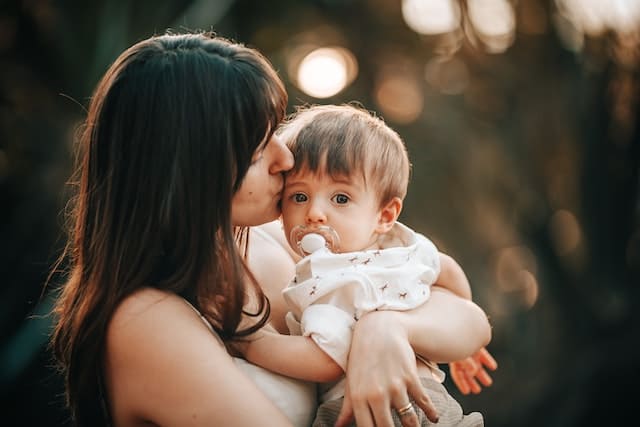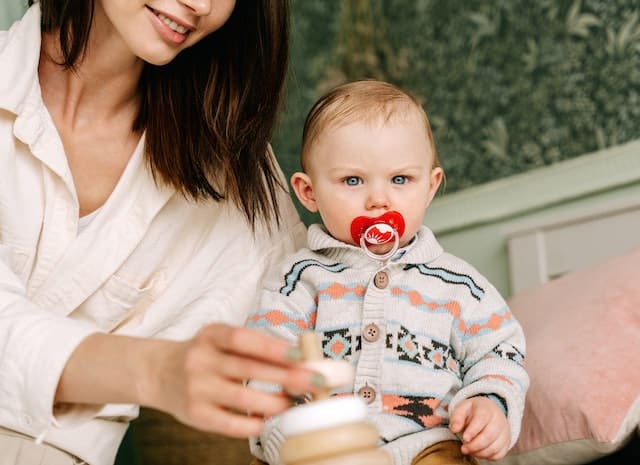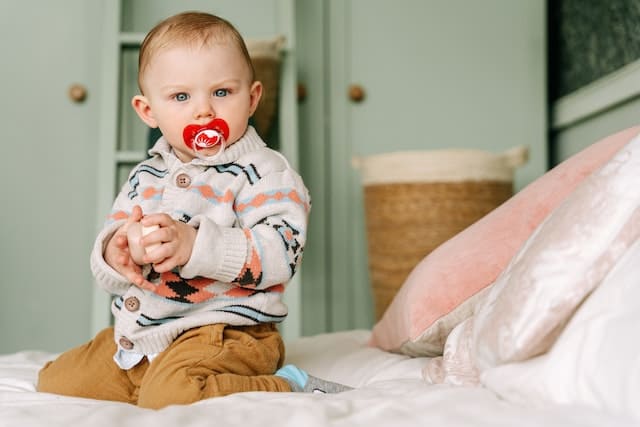Pacifiers can be a lifesaver for new parents struggling to soothe their fussy babies. But how many pacifiers do you really need? The answer is not as straightforward as you might think.
Understanding Pacifiers Pacifiers are a popular tool for calming babies and helping them fall asleep. They can also help reduce the risk of sudden infant death syndrome (SIDS). However, pacifiers can also have drawbacks, such as interfering with breastfeeding and causing dental problems if used for too long.
Choosing the Right Pacifier When it comes to choosing a pacifier, there are a few things to consider. Look for a pacifier that is the right size and shape for your baby’s mouth, and that is made of safe, non-toxic materials. It’s also a good idea to have a few different pacifiers on hand, in case your baby prefers one over the others.
Key Takeaways
- Pacifiers can have both benefits and risks for babies.
- When choosing a pacifier, look for one that is the right size and shape for your baby’s mouth, and made of safe materials.
- It’s a good idea to have a few different pacifiers on hand, in case your baby prefers one over the others.
Understanding Pacifiers
Pacifiers are a common item that many parents use to soothe their newborns. They are small, nipple-shaped objects that babies can suck on to help them feel comforted and calm. Pacifiers are often used to help babies self-soothe and can be a useful tool for parents to help their baby sleep or to calm them down when they are fussy.
Babies are born with a natural sucking reflex, which is why many newborns will instinctively suck on their fingers or hands. Pacifiers can be a helpful alternative to fingers or other objects that babies might try to suck on. Pacifiers can also help reduce the risk of Sudden Infant Death Syndrome (SIDS) when used during sleep.
It is important to note that pacifiers should not be used as a substitute for feeding. Babies need to feed frequently, especially in the first few months of life, and pacifiers should not be used to delay or replace feedings. Additionally, pacifiers should not be used as a way to quiet a hungry baby.
When choosing pacifiers, it is important to look for ones that are age-appropriate for your baby. Pacifiers come in different sizes and shapes, and it is important to choose one that is the right size for your baby’s mouth. Pacifiers should also be cleaned regularly to prevent the buildup of bacteria.
Overall, pacifiers can be a useful tool for parents to help soothe their babies and promote healthy sleep habits. However, it is important to use them responsibly and not rely on them as a substitute for feeding or as a way to quiet a hungry baby.
Benefits and Risks of Pacifiers
Pacifiers are a common item that many parents use to soothe their babies. While pacifiers can provide some benefits, there are also some risks associated with their use.
Benefits
- Soothes babies: Pacifiers can help calm a fussy or crying baby, providing them with comfort and security.
- Reduces SIDS risk: Studies have shown that pacifier use can reduce the risk of Sudden Infant Death Syndrome (SIDS) by up to 50%. It is recommended that parents offer a pacifier at naptime and bedtime.
- Helps with medical procedures: Pacifiers can be used to help distract and comfort babies during medical procedures, such as blood tests or vaccinations.
- Therapeutic benefits: Pacifiers can provide therapeutic benefits for premature babies, helping to improve their sucking reflex and overall development.
Risks
- Ear infections: Prolonged pacifier use can increase the risk of ear infections, especially if the pacifier is not cleaned properly.
- Dental issues: Extended pacifier use can cause dental problems, such as misaligned teeth or a misshapen palate.
- Dependency: Overuse of pacifiers can lead to a dependency on them, making it harder to wean the baby off of them.
- SIDS risk: Pacifiers should never be used as a substitute for safe sleep practices, such as placing the baby on their back to sleep. Improper use of pacifiers, such as attaching them to a string or cord, can increase the risk of SIDS.
Overall, pacifiers can provide some benefits for babies, but it is important to use them properly and be aware of the potential risks. Parents should consult with their pediatrician about the appropriate use of pacifiers and how to wean their baby off of them when the time comes.
Related Post: When is it Too Late to Start Breastfeeding
Choosing the Right Pacifier
Choosing the right pacifier for your baby can be a daunting task, especially for first-time parents. With so many options available in the market, it’s easy to get confused. However, with a little knowledge, you can make an informed decision and choose the best pacifier for your baby.
Material
Pacifiers are made of different materials, including silicone and rubber. Silicone pacifiers are more durable and easier to clean, while rubber pacifiers are softer and more flexible. Both materials are safe for babies, but some parents prefer one over the other.
Nipple Shape
The nipple shape is an important factor to consider when choosing a pacifier. Pacifiers come in different nipple shapes, including orthodontic and symmetrical. Orthodontic pacifiers are designed to mimic the shape of a mother’s nipple, while symmetrical pacifiers have a round nipple shape. Some babies prefer one over the other, so it’s important to try different nipple shapes to see which one your baby likes.
Ventilation
Some pacifiers have ventilation holes on the shield to allow air to circulate, which can help prevent skin irritation and reduce the risk of dental problems. However, not all pacifiers have ventilation, so it’s important to check before buying.
Safety
Safety is a top priority when choosing a pacifier. Look for pacifiers that are BPA-free and meet safety standards. Also, make sure the pacifier is the right size for your baby to avoid choking hazards.
Brands
There are many brands of pacifiers available in the market, and each brand has its own unique features. Some popular brands include Philips Avent, MAM, NUK, and Tommee Tippee. However, it’s important to remember that the most expensive brand doesn’t always mean the best quality.
Sizes
Pacifiers come in different sizes, and it’s important to choose the right size for your baby’s age. Using the wrong size pacifier can cause nipple confusion and affect your baby’s feeding habits.
Other Considerations
Other factors to consider when choosing a pacifier include scented pacifiers and natural rubber pacifiers. Scented pacifiers can help soothe your baby, while natural rubber pacifiers are eco-friendly and biodegradable.
In conclusion, choosing the right pacifier for your baby can be overwhelming, but with a little research and knowledge, you can make an informed decision. Consider the material, nipple shape, ventilation, safety, brands, sizes, and other factors when choosing a pacifier for your baby.
Pacifier Safety and Maintenance
Pacifiers can be a great comfort to babies, but it’s important to ensure their safety and cleanliness. Here are some tips for pacifier safety and maintenance:
Safety
- Always supervise your baby when they are using a pacifier.
- Check pacifiers regularly for signs of wear and tear, and replace them if they are damaged.
- Choose pacifiers with ventilation holes to prevent choking. Make sure the holes are not too big or too small, as this can pose a hazard.
- Use pacifier clips to prevent the pacifier from falling on the ground or getting lost. Make sure the clip is not too long and does not pose a strangulation hazard.
Sterilizing and Cleaning
- Before first use, sterilize pacifiers by boiling them for five minutes or using a sterilizing machine.
- After each use, clean pacifiers with warm, soapy water and rinse well. Alternatively, use a pacifier wipe or sterilizing solution.
- Do not clean pacifiers by putting them in the dishwasher or microwave, as this can damage them.
BPA-free and Silicone Pacifiers
- Choose pacifiers that are BPA-free to avoid exposing your baby to harmful chemicals.
- Silicone pacifiers are a good option as they are durable and easy to clean. They are also less likely to cause an allergic reaction compared to rubber pacifiers.
Rubber Pacifiers
- Rubber pacifiers can be a good option for babies who prefer them, but they require extra care. Check for signs of wear and tear regularly and replace them if they are damaged.
- Clean rubber pacifiers with warm, soapy water and rinse well. Do not use sterilizing solutions or expose them to high temperatures as this can damage the rubber.
By following these tips, parents can ensure their baby’s pacifiers are safe and clean, providing comfort and peace of mind.
How Many Pacifiers Do I Need
When it comes to pacifiers, parents often wonder how many they need to have on hand. The answer to this question depends on a few factors, such as the age of the baby and how frequently they use pacifiers.
For newborns, it is recommended to have at least 2-3 pacifiers on hand. This is because pacifiers tend to get lost or misplaced easily, and having a few backups can be helpful. As the baby grows and becomes more dependent on pacifiers, it may be useful to have more on hand.
When traveling, it is important to bring enough pacifiers to last the entire trip. It is also a good idea to pack a few extras in case they get lost or dirty. Many parents find it helpful to have a separate pacifier bag in their diaper bag to keep them organized and easily accessible.
When registering for baby items, it is a good idea to add a few pacifiers to the list. It is important to choose pacifiers that are appropriate for the baby’s age and development stage. It is also helpful to have a variety of pacifiers with different shapes and sizes to see which ones the baby prefers.
Finally, it is important to replace pacifiers regularly, as they can become worn out or dirty over time. It is recommended to replace pacifiers every 2-4 weeks, or sooner if they show signs of wear and tear.
In summary, the number of pacifiers needed depends on the baby’s age and usage, and it is important to have backups and replacements on hand. When traveling or registering for baby items, it is important to consider the number and type of pacifiers needed.
When and How to Use Pacifiers
Pacifiers can be a useful tool for parents to soothe their fussy babies. However, it is important to know when and how to use pacifiers effectively.
Age
According to the American Academy of Pediatrics (AAP), it is safe to introduce pacifiers to babies after breastfeeding is established, typically around 3-4 weeks of age. It is recommended to stop using pacifiers by 6-12 months of age to avoid potential dental problems.
Soothing and Calming Effect
Pacifiers can be a helpful tool to soothe and calm babies. They can be used to distract babies from hunger or discomfort and help them fall asleep. However, it is important to not rely solely on pacifiers to calm a baby and to address any underlying issues that may be causing fussiness.
Bedtime
Using a pacifier at bedtime can help babies fall asleep and stay asleep. However, it is important to not rely on pacifiers to put babies to sleep and to establish a consistent bedtime routine.
Distraction
Pacifiers can be used as a distraction for babies during times of stress or discomfort, such as during vaccinations or when traveling. However, it is important to not use pacifiers as a substitute for addressing the underlying issue.
In conclusion, pacifiers can be a useful tool for parents to soothe their babies. However, it is important to use them appropriately and not rely on them as a substitute for addressing underlying issues.
Weaning Off Pacifiers
Weaning off pacifiers can be a challenging task for both parents and children. However, it is an important step towards promoting healthy oral development and preventing dental problems in the future. Here are some tips to help make the weaning process smoother:
Start Early
It is recommended to start weaning off pacifiers by the age of 2 or earlier, as prolonged use of pacifiers can lead to dental problems such as misaligned teeth and overbites.
Parents can gradually reduce the frequency and duration of pacifier use, and encourage their child to self-soothe through other means such as cuddling or a favorite stuffed animal.
Be Consistent
Consistency is key when weaning off pacifiers. Parents should establish a clear plan and stick to it, even if it means dealing with some temporary fussiness or tantrums from their child.
It is important to avoid going back and forth between using and not using pacifiers, as this can confuse the child and make the weaning process more difficult.
Involve Your Doctor or Dentist
Parents can consult with their child’s doctor or dentist for additional guidance and support during the weaning process. They can provide recommendations on the best timing and methods for weaning, as well as monitor the child’s oral development and address any concerns or issues that may arise.
Overall, weaning off pacifiers can be a challenging but necessary step towards promoting healthy oral development in children. With patience, consistency, and support from healthcare professionals, parents can help their child successfully transition away from pacifiers and towards other self-soothing methods.
Related Posts:
Frequently Asked Questions
What is the recommended number of pacifiers for a newborn?
It is recommended to have at least 2-3 pacifiers on hand for a newborn. This allows for a clean pacifier to be readily available when one gets dirty or lost. However, it is important to note that not all babies will take to pacifiers, and some may prefer a certain brand or style over others.
How often should I replace pacifiers?
Pacifiers should be replaced every 2-4 weeks, or sooner if they become damaged or worn. It is important to inspect pacifiers regularly for signs of wear and tear, such as cracks or tears in the nipple or shield.
What are the most popular pacifier brands for babies?
Some of the most popular pacifier brands for babies include Philips Avent, NUK, MAM, and Dr. Brown’s. However, it is important to note that every baby is different and may have their own preferences when it comes to pacifiers.
Is it possible to have too many pacifiers for my baby?
While it is possible to have too many pacifiers, it ultimately depends on the needs and preferences of your baby. It is recommended to have a few pacifiers on hand, but having too many may lead to confusion and difficulty in keeping track of them.
Do I need pacifier holders for my baby?
Pacifier holders can be helpful in keeping pacifiers clean and easily accessible. However, they are not necessary and some babies may not take to them. It ultimately depends on the needs and preferences of your baby and family.
How much should I expect to spend on pacifiers for my baby?
The cost of pacifiers can vary depending on the brand and style. On average, pacifiers can range from $3 to $10 each. It is recommended to have a few pacifiers on hand, but it is important to stay within your budget and not overspend.

Iesha is a loving mother of 2 beautiful children. She’s an active parent who enjoys indoor and outdoor adventures with her family. Her mission is to share practical and realistic parenting advice to help the parenting community becoming stronger.



